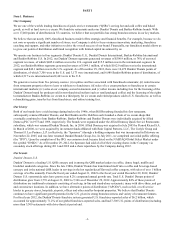Baskin Robbins 2012 Annual Report Download - page 21
Download and view the complete annual report
Please find page 21 of the 2012 Baskin Robbins annual report below. You can navigate through the pages in the report by either clicking on the pages listed below, or by using the keyword search tool below to find specific information within the annual report.-11-
on our business. In addition, our competitors, some of whom have greater resources than us, may be able to benefit from
changes in technologies or consumer acceptance of alternative methods of delivery, which could harm our competitive position.
There can be no assurance that we will be able to successfully respond to changing consumer preferences, including with
respect to new technologies and alternative methods of delivery, or to effectively adjust our product mix, service offerings and
marketing and merchandising initiatives for products and services that address, and anticipate advances in, technology and
market trends. If we are not able to successfully respond to these challenges, our business, financial condition and operating
results could be harmed.
Economic conditions adversely affecting consumer discretionary spending may negatively impact our business and
operating results.
We believe that our franchisees' sales, customer traffic and profitability are strongly correlated to consumer discretionary
spending, which is influenced by general economic conditions, unemployment levels and the availability of discretionary
income. Negative consumer sentiment in the wake of the economic downturn has been widely reported over the past four years
and may continue in 2013. Our franchisees' sales are dependent upon discretionary spending by consumers; any reduction in
sales at franchised restaurants will result in lower royalty payments from franchisees to us and adversely impact our
profitability. If the economic downturn continues for a prolonged period of time or becomes more pervasive, our business and
results of operations could be materially and adversely affected. In addition, the pace of new restaurant openings may be
slowed and restaurants may be forced to close, reducing the restaurant base from which we derive royalty income. As long as
the weak economic environment continues, our franchisees' sales and profitability and our overall business and operating
results could be adversely affected.
Our substantial indebtedness could adversely affect our financial condition.
We have a significant amount of indebtedness. As of December 29, 2012, we had total indebtedness of approximately $1.9
billion, excluding $11.5 million of undrawn letters of credit and $88.5 million of unused commitments under our senior credit
facility.
Subject to the limits contained in the credit agreement governing our senior credit facility and our other debt instruments, we
may be able to incur substantial additional debt from time to time to finance working capital, capital expenditures, investments
or acquisitions, or for other purposes. If we do so, the risks related to our high level of debt could intensify. Specifically, our
high level of debt could have important consequences, including:
• limiting our ability to obtain additional financing to fund future working capital, capital expenditures, acquisitions or
other general corporate requirements;
• requiring a substantial portion of our cash flow to be dedicate to debt service payments instead of other purposes,
thereby reducing the amount of cash flow available for working capital, capital expenditures, acquisitions and other
general corporate purposes;
• increasing our vulnerability to adverse changes in general economic, industry and competitive conditions;
• exposing us to the risk of increased interest rates as certain of our borrowings, including borrowings under the senior
credit facility, are at variable rates of interest;
• limiting our flexibility in planning for and reacting to changes in the industry in which we compete;
• placing us at a disadvantage compared to other, less leveraged competitors or competitors with comparable debt at
more favorable interest rates; and
• increasing our costs of borrowing.
Our variable rate debt exposes us to interest rate risk which could adversely affect our cash flow.
The borrowings under our senior credit facility bear interest at variable rates. Other debt we incur also could be variable rate
debt. If market interest rates increase, variable rate debt will create higher debt service requirements, which could adversely
affect our cash flow. In September 2012, we entered into variable-to-fixed interest rate swap agreements to hedge the floating
interest rate on $900.0 million notional amount of our outstanding term loan borrowings. While these agreements limit our
exposure to higher interest rates, they do not offer complete protection from this risk given the total amount of our outstanding
variable rate indebtedness.
























